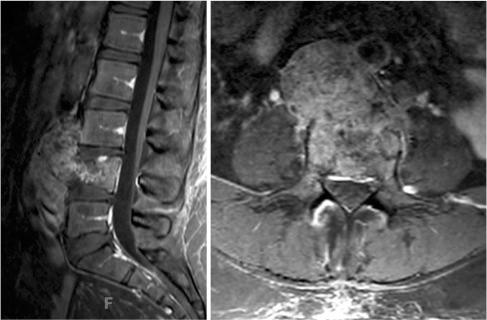Physical Address
304 North Cardinal St.
Dorchester Center, MA 02124
© 2018 Elsevier Inc. All rights reserved. Please note that the copyright for the original figures submitted by the contributors is owned by Contributors.
Chordomas and chondrosarcomas are both primary malignant (locally aggressive) bone tumors. Chordomas are considered the most common primary malignant bone tumor of the spine and sacrum, with an incidence of 0.08 per 100,000 persons. These lesions arise from notochordal remnants and have a slow-growing, locally aggressive nature; metastases occur in 5%–40% of patients. They are more common in men, and the estimated 10-year survival rate is between 39% and 64%. The best long-term prognosis is achieved following wide en bloc resection.
On the other hand, chondrosarcomas are a heterogeneous group of malignant tumors that are characterized by their ability to form cartilage. The occurrence of chondrosarcomas in the spine is very rare, representing only 4%–10% of all chondrosarcomas ; the incidence is 0.5 cases per 100,000 persons per year, lower than the incidence of chordoma. Chondrosarcomas are more common in the thoracic spine and may arise de novo or as a secondary transformation from osteochondromas. Additionally, chondrosarcomas can arise in the context of hereditary multiple exostosis. The best long-term prognosis occurs after marginal or wide marginal en bloc resection, but the critical proximity to vital neural and vascular structures in the spine makes this difficult to achieve. Moreover, some chondrosarcomas are resistant to chemotherapy and radiotherapy, and have a high tendency of recurrence.
Given that the best long-term prognosis for both chordoma and chondrosarcoma is en bloc resection, the purpose of this chapter is to give an overview of the surgical management of these lesions in the lumbar spine.
Given the unique anatomy surrounding the lumbar spine, performing a spondylectomy in this area is challenging. Indications for surgery include primary spinal tumors not amenable to radiation/chemotherapy, metastatic disease, and a solitary symptomatic lesion. Contraindications include tumors adherent or invading the vena cava, abdominal aorta, or adjacent visceral organs. A relative contraindication is tumors involving more than three vertebrae.
Tomita et al. described a classification system to determine which patients could undergo total en bloc spondylectomy. The system classifies the anatomic location of the tumor as follows: (1) vertebral body, (2) pedicle, (3) lamina and spinous process, (4) spinal canal (epidural space), or (5) paravertebral area. This classification is the basis of the “Surgical Classification of the Vertebral Tumors” system. A type 3 lesion, for example, involves areas 1, 2, and 3; a type 5 lesion involves the vertebral body (1), pedicle (2), lamina (3), spinal canal (4), and paravertebral area (5). A type 6 lesion involves all of the previously mentioned areas plus adjacent vertebra, and a type 7 lesion consists of multiple, skip lesions. Type 1, 2, and 3 lesions are considered intracompartmental (they do not go beyond the vertebra) and type 4, 5, and 6 are considered extracompartmental. Based on this system, spondylectomy is recommended for type 2, 3, 4, and 5 lesions, relatively indicated in type 1 and 6 lesions, and not recommended for type 7 lesions.
Preoperative planning should also include imaging, particularly magnetic resonance imaging (MRI) and computed tomography (CT) scans. These allow assessment of neural and soft-tissue involvement, and the extent of bony destruction. MRI should include T1-weighted images, T2-weighted images, and images with gadolinium contrast ( Fig. 27.1 ).

Become a Clinical Tree membership for Full access and enjoy Unlimited articles
If you are a member. Log in here